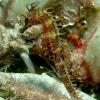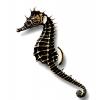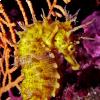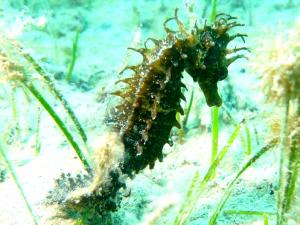Il cavalluccio di mare (Hippocampus guttulatus Cuvier, 1829) è un pesce d'acqua salata appartenente alla famiglia Syngnathidae, diffuso nel Mar Mediterraneo. In provincia di Salerno si trova lungo le coste. E' una creatura marina rara ed affascinante. E' spesso reperibile in prossimità di alghe, Posidonia oceanica e Zostera a cui si appiglia con la coda.
Di conformazione fisica tipica del cavalluccio marino ha la particolarità di presentare sul corpo e sulla testa numerose escrescenze appuntite formate dall'esoscheletro. La livrea è uniforme, di colore giallo, talvolta marrone o rossastro, con fasce irregolari bianche. Raggiunge una lunghezza massima di 15 cm.
È una specie ovovipera. La femmina, dopo la fecondazione, depone le uova nella tasca posta sul ventre del maschio. Egli coverà le uova per 2-5 settimane fino alla loro schiusa, quando piccoli già formati usciranno dal ventre paterno.
Hippocampus guttulatus ha dieta onnivora: si nutre di piccoli pesci ed alghe.
Il minuscolo scheletro, formato da piastre ossee, sostiene gli organi vitali dell'esile animale che si sposta in acqua utilizzando delle minuscole pinne. La pinna dorsale è la più importante, permette al cavalluccio di spostarsi in maniera alquanto rapida e precisa. Le pinne laterali, posizionate appena dietro alla testa che ricorda quella di un piccolo cavallo, sono utilizzate per gli spostamenti e le manovre più complesse.
Il muso allungato e la piccola bocca lo costringono ad una dieta alimentare assai limitata e specifica. Una bocca priva di denti che risucchia le piccole prede.
Il corpo è solitamente formato da una cinquantina di anelli ossei mentre sulla testa e su quasi tutto il dorso sono presenti evidenti ramificazioni.
La coda, organo fondamentale per il cavalluccio marino, è prensile. Questa permette all'animale un facile ancoraggio al fondale.
Un habitat particolare quello frequentato da questo simpatico e fragile animale: acque basse e costiere, fondali detritici con presenza di alghe oppure le classiche praterie di poseidonia oceanica, tipiche di molte zone del Mediterraneo.
Negli ultimi anni la presenza di questi splendidi animali si è fatta sempre più rara fino al punto di considerarli in moltissime zone scomparsi o almeno a rischio di estinzione.
Il cavalluccio marino è presente anche nella mitologia degli antichi greci e dei romani.
L'Ippocampo è un animale mitologico che figurava nel corteo di Poseidone, per metà cavallo e per metà pesce. Da qui il nome Ippocampo composto dai due nomi greci Hippos (cavallo) e Kampos (mostro).

The long-snouted seahorse is a saltwater fish belonging to the Syngnathidae family, common in the Mediterranean Sea. In the province of Salerno it is located along the coast. It’s a rare and fascinating marine creature, often found in the vicinity of seaweed, Posidonia oceanica, and zostera clinging with its tail.
The skin is yellow, sometimes brown or reddish, with irregular white bands. It reaches a maximum length of 15 cm. It is an ovivipary species. The female, after fertilization, lays eggs in the pocket on the male's abdomen. The male will hatch the eggs for 2-5 weeks until they hatch, when offspring already formed will leave the paternal belly. The species has omnivorous diet: it feeds on small fish and algae.
The tiny skeleton, made up of bony plates, supports the vital organs of the thin animal that moves on the water using tiny fins. The dorsal fin is the most important, enables the horse to move rather quickly and precisely. The side fins, positioned just behind the head that resembles that of a small horse, are used for moving and more complex movements.
A long snout and small mouth forced him to a very limited diet and specific. A mouth devoid of teeth that sucks the small prey.
The body is usually made up of about fifty bony rings. The tail, major organ for seahorse, is prehensile. This allows the animal easy anchoring to the seabed. Particular habitats for with this cute and fragile animal are shallow waters and coastal waters with weeds or debris classic prairies of Posidonia oceanica, typical of many areas of the Mediterranean.
In recent years the presence of these beautiful animals has become rarer to the point of considering in most areas disappeared or at least endangered.
The seahorse is also present in the mythology of the Greeks and Romans. It is a mythological animal that appeared in Poseidon's parade, half-horse, half-fish. Hence the name Hippocampus composed of the two Greek names Hippos (horse) and Kampos (monster).






